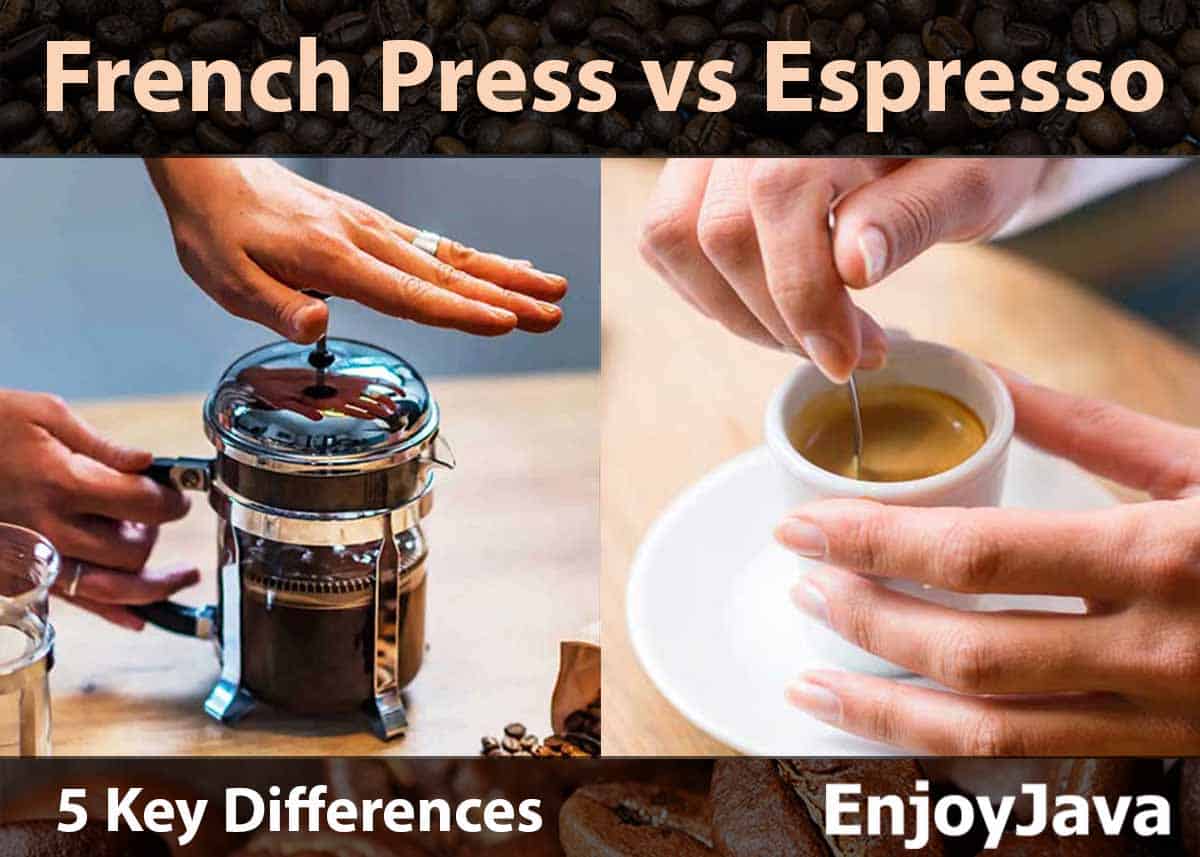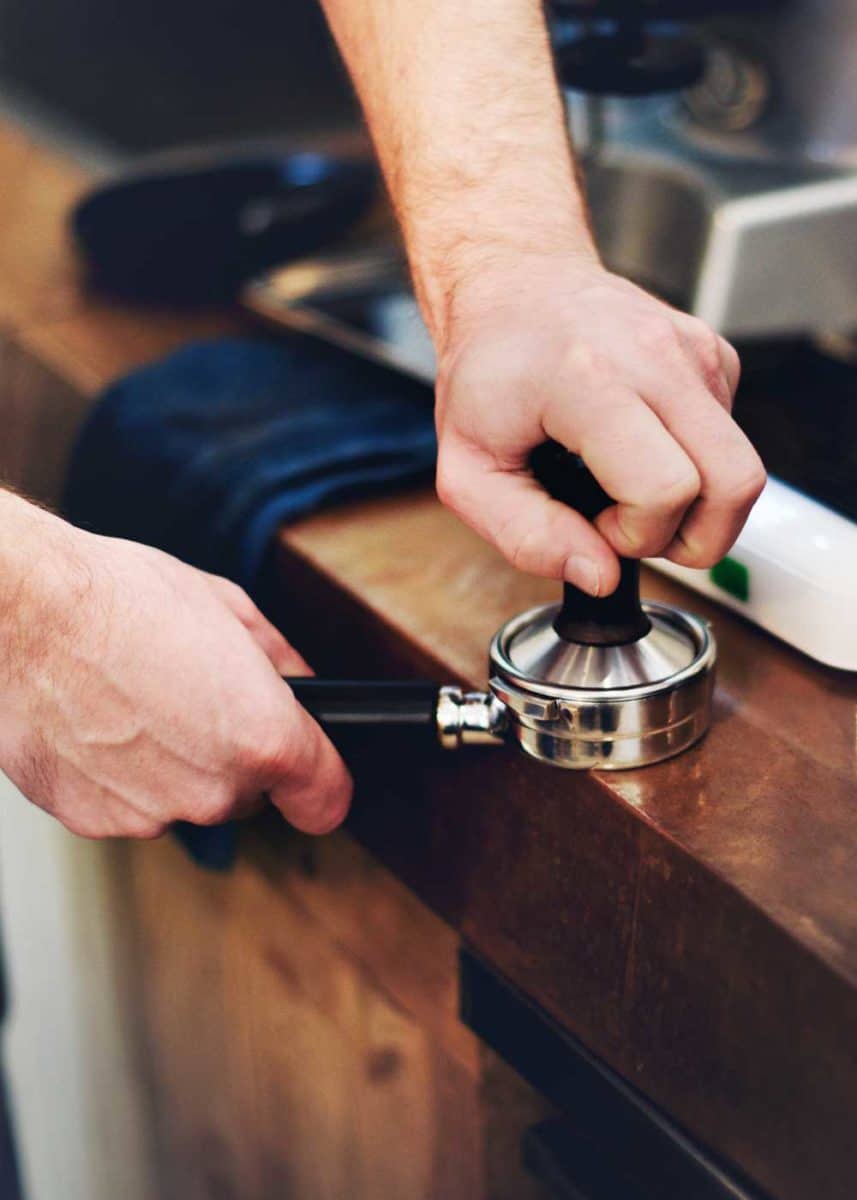Do you love the rich, bold flavor of espresso but also enjoy a more mellow cup? If so, then it’s time to explore the key differences between French press vs espresso coffee. Both types of brewing have their own distinct tastes, allowing you to savor whichever suits your taste.
The French press method is a simple way to brew great coffee. It is served at similar strength and volume to standard drip coffee. Espresso requires an espresso machine and more skill. Espresso is known for its rich flavor profile and small cups. Both brewing methods yield distinct results.

Some obvious differences include the size of the cup (espresso requires a demitasse cup, much smaller than a traditional coffee mug) and their origins: espresso is an Italian invention, while French press coffee comes from, well, France.
To begin, let’s consider the specifics of each drink. And then we’ll compare the differences.
What is French Press Coffee?
French press coffee is a simple, manual brewing process. You don’t need filters or electricity. Just a source of hot water, coffee grounds, and a French press.
What is Espresso Coffee?
Espresso is a small shot of concentrated coffee. It is thicker than coffee and has a much stronger flavor.
The word espresso is Italian meaning “pressed.” Hot water (195 – 205 °F / 90 – 96 °C) is forced through finely-ground coffee using pressure. It produces a thick, concentrated liquid that can be consumed on its own or added to other drinks.
Espresso consists of three distinct parts: the heart, the body, and the crema. Most coffee shops will use a dark roast coffee bean for their espresso.
Some of the best coffee comes from Italy. Here’s how to order coffee in Italy.
French Press vs Espresso: What’s the Difference?
From equipment needed to taste profile, understanding these two different brewing processes is essential for any coffee lover looking to make the perfect cup every single time.
Learn about how each method works and what makes them special as we dive into exploring the key differences between a French press vs espresso.
1. French Press vs Espresso: Brewing Method
French press and espresso are two of the most popular coffee brewing methods.
- French press is a manual method that uses a plunger to steep ground coffee in hot water
- Espresso requires a machine that uses high pressure and temperature to extract flavor from finely-ground beans.
Making French Press Coffee
The French press method is relatively simple and can be done by anyone at home with minimal equipment.
All you need is a pot or carafe, coarsely-ground coffee, hot water, and the plunger device.
- To make it all happen, simply add your grounds to the carafe and pour in some hot water.
- Mix the grounds and hot water, press the plunger until it hits bottom, and steep for four minutes. Simple.
Here’s a great 5-step recipe for French press coffee.

Making Espresso
Espresso takes more skill than a French press but yields delicious results when done correctly. An espresso machine forces pressured steam through very fine grinds to create an intense flavor profile with more caffeine per ounce than other brewing methods.
- You’ll need freshly roasted, whole bean coffee ground into an extra fine, powder-like consistency, and a portafilter basket. You’ll also want to use filtered water for the best results since minerals found in tap water can affect taste quality.
- Tamp down the grounds in the basket before inserting it into your machine and pulling shots according to manufacturer instructions until desired strength/flavor profile has been achieved.
Here are the 8 steps to making a perfect espresso shot.

Curious about pronunciation? Is it expresso or espresso?
2. Beans: Roast and Grind for French Press vs Espresso
Choosing the right beans (variety, roast, and grind) for your brew method is very important.
Ideal Beans and Grind for French Press
Arabica beans are commonly used for making coffee with a French press.
- Roast: Light or medium roast beans are the most common. But this depends on personal preference.
- Grind: Coarsely ground. If ground too finely, the flavor will be negatively affected. And the mesh filter won’t be able to prevent the particulate from getting into the brewed coffee.
Ideal Beans and Grind for Espresso
Espresso beans are often a blend of Arabica with some Robusta beans added for crema.
- Roast: Espresso beans are dark roast, meaning that they have been roasted longer,
- Grind: Finely ground. If you use regular ground coffee, you’ll be disappointed. It must be finely ground to allow for maximum extraction.
Here’s how espresso beans differ from regular coffee beans.
3. Taste Profile of French Press vs Espresso
When it comes to the taste profile of French press vs espresso, there are some distinct differences.
- A French press brews coffee with lower acidity than espresso, and the flavor notes you’ll find in a French press cup can range from earthy and nutty to sweet and fruity depending on the bean variety used.
- Espresso’s finely ground beans produce bright acidity and complex flavors like dark chocolate, caramel, or even citrus zest depending on the type of bean used.
French press has less body than espresso due to its brew method which gives it a lighter mouthfeel.
Here are 240+ flavorful words to describe coffee.
4. Equipment Needed: French Press vs Espresso
Brewing great java involves a range of approaches and equipment. French press and espresso brewing require different items for effective brewing.
Let’s take a look at what’s needed for each method.
French press equipment
A French press is an easy-to-use manual device that requires minimal setup and cleanup. All you need is ground coffee beans, hot water, and a French press pot with plunger lid.
The most important thing when using this method is getting the grind of your beans just right. If your beans are ground too coarsely, you’ll get a weaker cup of coffee, while too fine a grind can result in bitterness (though that quality can help emphasize other flavors).
Equipment needs for a cup of French press coffee are minimal. And you can also use store-bought grounds if you don’t want to grind your own beans.
Espresso equipment
The equipment needed for a cup of espresso is more involved, as you need a machine to do it.
To make espresso yourself, you’ll need an espresso machine. And they can get pricey. They can run from $500 to $1000+.
There are some lower-cost options that are worth checking out. We’ve had great success with the Breville Cafe Roma espresso maker. This runs in the $200 depending on your country and time of year.
In addition, you can’t just put regular coffee grounds in your espresso machine. Well, you can, but you won’t get the results you’re after. You’ll also need a coffee grinder capable of grinding beans into the necessary grind consistency. Without this step, not even the priciest espresso machine will give you the desired results.
5. Health Benefits and Concerns
So many studies come and go, but some may affect your choice between French press vs espresso.
A couple of studies showed that the higher caffeine content in espresso may contribute to improvement in memory performance.
On the other hand, French press can present a risk for higher levels of LDL cholesterol in those drinkers already having problems with those levels. However, overindulgence played a large part in those higher levels, so moderation remains a good thing.
Learn more about other types of coffee.
Final Thoughts
The key differences between a French press and espresso reside in their brewing methods, taste profiles, and equipment needs.
My personal preference is espresso. I don’t mind French press, but it lacks the strength and flavor profile of espresso. And espresso is super versatile.
Ultimately, it comes down to personal preference as both drinks offer unique experiences appealing to different tastes.
- About the Author
- Latest Posts
Bryan Haines is a co-founder and writer on EnjoyJava – and is working to make it the best coffee blog in the world.
He is a travel blogger at Storyteller Travel and blogs about photography at Storyteller Tech. He is also co-founder of Storyteller Media, a company he started with his wife, Dena.
